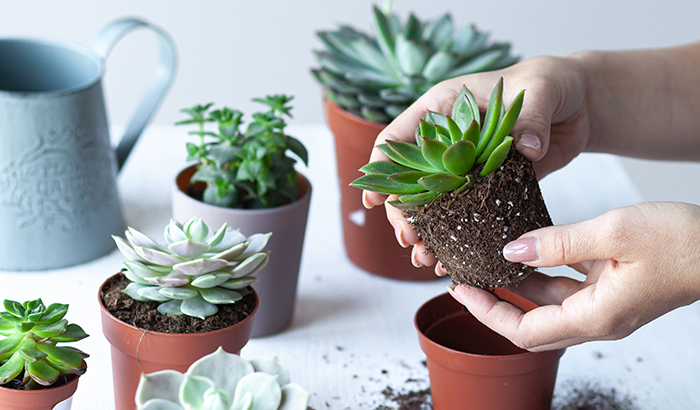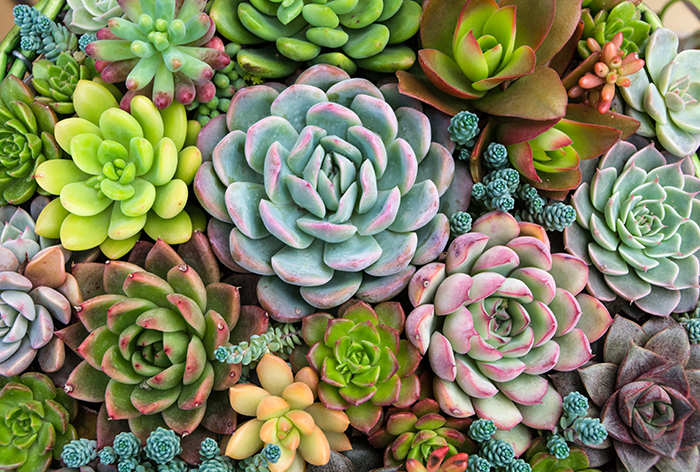How to grow and care for succulents
"Succulents” are thick, fleshy plants that have evolved to store water so they can survive in arid climates or tough soil conditions. Often the water is stored in the leaves, giving many of them their signature puffy, cactus-like appearance. The truth is, while succulents look great, they can sometimes be difficult to care for.

The right conditions are essential to the health of your succulent garden, so read on for how to grow and care for different types of succulent plants.
Types of succulents
There are many types and subtypes of succulents. Let’s take a look at some popular varieties that can usually be found in your local garden store:
- Haworthia
- Sempervivum
- Echeveria
- Aloe
- Crassula
- Kalanchoe
Frequently asked questions on how to care for succulents
1.
Do succulents need light?
Succulent plants require a substantial amount of light in order to thrive. They
grow best in bright, indirect sunlight for about six hours per day. If your
plant is not getting enough light, you may notice it start to get leggy or “reach”
for the sun. In this case, try to place it in as much light as possible for at
least four hours each day.
2.
How often should you water
succulents?
The general rule is to water more, less frequently. Make sure your plants
receive adequate moisture in the summer with relatively drier conditions in the
winter. When you do water, it’s important to give a thorough soak that will
reach the roots. Some succulent gardeners suggest submerging a pot with
drainage holes in a shallow saucer with water for five to ten minutes. If you
do this, make sure to empty the saucer afterwards so your succulent is not
standing in water for too long. With the exception of when you water, your
plant’s roots should be protected from excess moisture as much as possible.
3.
What kind of pots should I use for
my succulent plants?
The most important thing to consider when it comes to potting is sufficient
drainage. Avoid any containers without drainage holes, such as glass bowls or
terrariums, unless you are able to put a thick layer of pebbles at the bottom.
If you try this, monitor the situation closely as this may prove too moist for
a fussy plant.
4.
How can I tell if I overwatered my
succulent?
Yellowed leaves are normal and are no cause for concern if they’re the
outermost, oldest leaves on a mature succulent. However, if you start to notice
yellowing or brown leaves, especially translucent leaves that turn mushy or
fall off easily if touched, it is likely your plant is suffering from chronic
overwatering.
5.
Are succulents safe for pets?
Echeveria, haworthia, and sempervivum are examples of succulent varieties that
are safe to have around pets. Others such as aloe, jade, kalanchoe, and
euphorbia can cause gastrointestinal upset, vomiting and other unwanted
symptoms if ingested. For more information on which types of plants to avoid if
you have pets, consult this helpful resource provided by the American Society for the Prevention of Cruelty to Animals.
How to propagate succulents
One of the best parts of growing succulents is that they are very easy to reproduce. There are several ways to do this; such as by leaf, stem or rosette.

To propagate with a leaf, start by carefully snapping one away from the main stem of the plant by gently wiggling it side to side until it pops off.
Place the leaf flat on a tray and allow it to dry – or “callus over” – for a few days before placing it in a bright location out of direct sunlight. Consider propagating more than one leaf, as it is completely normal that some cuttings will not survive.
After a few days, examine the cuttings for small, hair-like roots. Place the new rooted cuttings on a thin layer of soil and mist or water sparingly as you would with a mature succulent.
After about one month, tiny plants will begin to develop at the end of the leaves. Continue to let them grow from the leaf as it is supplying the new succulent with energy and nutrients. Over time, the old leaf will shrivel as the new succulent continues to grow.
You can use this method to propagate many different kinds of succulents for a beautiful, lush succulent garden.
In conclusion, learning how to grow and care for succulents can be a rewarding endeavor for any level of gardener who takes the time to understand and care for these hardy, low maintenance plants.
Are you passionate about real estate? Subscribe to the Centris.ca newsletter now.
See also:
How to take care of a peace lily
How to keep your houseplants healthy
17 best low-maintenance indoor plants
 The Largest Number of Homes for Sale
The Largest Number of Homes for Sale



